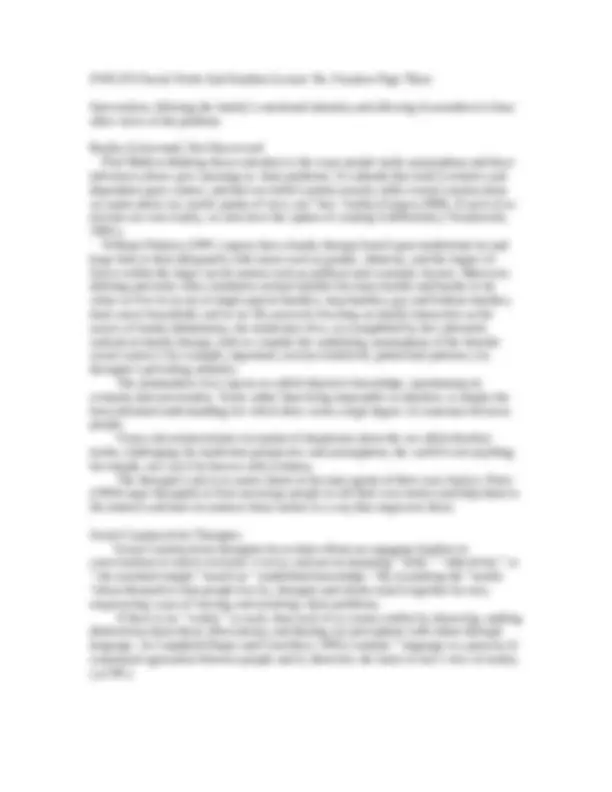








Study with the several resources on Docsity

Earn points by helping other students or get them with a premium plan


Prepare for your exams
Study with the several resources on Docsity

Earn points to download
Earn points by helping other students or get them with a premium plan
Community
Ask the community for help and clear up your study doubts
Discover the best universities in your country according to Docsity users
Free resources
Download our free guides on studying techniques, anxiety management strategies, and thesis advice from Docsity tutors
Material Type: Notes; Class: Social Work Practice with Families; Subject: Social Work; University: University of Southern Mississippi; Term: Unknown 2003;
Typology: Study notes
1 / 11

This page cannot be seen from the preview
Don't miss anything!







SWK 674 Social Work And Families Lecture No. Fourteen Page One Social Construction Models: Solution-Focused Therapy, Collaborative Therapy and Narrative Therapy. Postmodernists began in the 1980’s, they contended that multiple views of reality existed and that absolute truth could never be known. This challenge to taken-for –granted assumptions- in religion, the arts, and politics, in addition to the sciences- represented a deconstruction of fixed ways of thinking, leading to exploration of new assumptions and the development of new constructions. The postmodern movement, along with its constructivist epistemology- the view that each person involved constructs his or her personalized views and interpretations of what might be experience together-has had a particularly significant impact on the field of family therapy, and is at the cutting edge of today’s practice. The postmodern social construction outlook offers a direct challenge to systems thinking, especially of the first-order cybernetic type, by focusing on examining the assumptions clients make about their problems rather than conceptualizing their differences in terms of interactional behavior and feedback loops. Collaboratively helping clients seek new meaning through mutual inquiry replaces the therapist as outside expert. In this new view, the therapist walks alongside the clients toward a previously unknown destination of new meaning and action ( Anderson, 2003 ). The postmodern view rejects the dogmatic notion that the therapist sees the world as it really is, while clients distort their picture of reality. Instead, therapists influenced by social constructivist thinking are apt to take a “ not knowing “ stance ( Anderson & Goolishan, 1988), replacing the predetermined view of how a family should change with a collaborative posture in which all participants-family members and the therapist equally as co-investigators-examine the belief systems by which the different family members view “ reality. “ After each family member has considered his or her own assumptions about the world that form the basis for the meanings he or she gives to events, the family and therapist are in a position, together, to generate or co-construct new vies of the family’s “ reality “ and new options its members might pursue. Instead of concentrating on the origins of the problems, the therapist turns, together with family members, to finding workable solutions-searching for the possibilities rather than the pathology.. In the process, the family may be helped to clarify and revise some of the central themes of its personal narratives or stories about its members. Post modernist thinkers emphasize that our beliefs about the world-what constitutes reality-are social inventions, not a reflection of the map of the world; they evolve from conversations with other people. Social Constructivists believe that terms like “ Gay”, “ Bipolar” or “ Borderline “ are invented terms-social constructions- that we personify, as if they existed. In the post modern view, each is simply a contrived and invented label that clients and therapists alike bring into therapy. This can be a useful and handy way of communicating. But it can also have a dangerous consequence. Michael De Shazer ( 1991) maintains, because as therapists we run the risk of reifying concepts borrowed from first-order cybernetics ( such as homeostatis ) and describing families as though families really possess those concepts- and those concepts explain their problems.
SWK 674 Social Work And Families Lecture No. Fourteen Page Two Postmodern thinkers employ the construct of constructivism to emphasize the subjective nature of reality. Our knowledge of the world derives from our own creating, ordering, constructing, and giving meaning to what we experience, not a world as it objectively exists. That is, each of us constructs a sense of the world out there based on our own previously held dominant beliefs, which in turn reflect the dominant beliefs of society. Those beliefs are kept alive and passed along through stories or narratives we share in conversations with one another. Moreover, these narratives play a key role in organizing and maintaining a view of ourselves and our life situations. People organize their experiences and even their memories primarily in the form of self-narratives- personal and family stories, myths about family characteristics or circumstances, reasons for doing or not doing something-to gain some sense of order, continuity and meaning in their lives. A Postmodern Therapeutic Outlook The therapist is no longer a detached, powerful outside observer or sole expert but rather a partaker, with his or her own set of beliefs, ready to play a role with family members in constructing the reality being observed. Instead of presenting the familiar detached and presumed “objective “ assessment by an expert, social constructionists take the position that what is called for is a collaborative dialogue between therapist and family, who respectfully and non judgmentally hold “ conversations “ in which they examine the meanings each participant has given to the family’s problems. For example, Harlene Anderson ( 1997 ) Not Knowing Stance allows the therapist to follow leads as openings develop rather than imposing some predetermined scheme or framework for uncovering problems. There is increased likelihood to attend to diversity issues. Also clients and therapists alike are empowered by believing that their situation is changeable. The Post Milan Link To The Postmodern View Boscolo and Cecchin moved toward a second-order cybernetic viewpoint. This was a joint non hierarchical relationship with families in order to encourage self-examination and provide an opportunity for change without adhering to any prior agenda set by the therapists as to specific therapeutic goals. Boscolo and Cecchin took the position that therapists should invite family members to examine their meaning system, and explore their options, instead of intervening with therapist-formulated directives. Together, therapist and families can co-construct new ways of considering their choices, creating the possibility of discovering previously unexplored ways of looking at their situation and its remediation. Circular questioning ( “ Which one of your parents would you turn to in an emergency? “ Who in the family shows the most upset when your parents quarrel? “) is especially facilitative here, orienting all of the participants to seeing themselves within a relationship context while learning of each other’s perspective on what is taking place within the family. The initial systemicist efforts to take a neutral stance and employ circular questioning led its creators to understand that the questioning process itself is an
SWK 674 Social Work And Families Lecture No. Fourteen Page Four Social constructivist therapists have shifted in attention away from an inspection of the origin or the exact nature of a family’s presenting problems to an examination of the stories ( interpretations, explanations, theories about relationships ) family members have told themselves that account for how they have lived their lives. Social constructivist therapists are particularly interested in expanding the client’s rigid and inflexible views of the world, since such dogmatic convictions, usually negative, make alternative explanations of events or relationships difficult if not impossible for clients to consider. Solution-Focused Brief Therapy ( SFBT ) Solution-Focused therapists listen to the language used as families describe their situations and the conflict resolution they hope to achieve. Led by the therapist, but directed by client goals, family members construct possible solutions together to reach these goals. Instead of “ problem talk “ ( searching for explanations of client problems by piling “facts” upon “facts” about their troubled lives ) these pragmatic, minimalist therapists urge “solution talk” ( in which therapist and clients discuss solutions they want to construct together ). For example, instead of saying to a family in the initial session, “ Tell me what problems brought you to see me,” the solution-focused therapist might ask, “ How can we work together to change your situation ?” Operating from a social constructivist orientation ( De Shazer,1991 ), the therapist sets the stage for dialogue, brings forward the expectation that change will take place, and solicits the client’s active and collaborative participation in achieving change. If numerous realities exist, with each reality being arbitrarily and subjectively based on personal constructions of stories of what’s out there, then we agree to call reality is nothing more than a consensus about our perspectives shared through language. Workable solutions result from the re-descriptions of themselves- in effect the family creates new, empowering stories about themselves. If successful, clients achieve a cognitive change, reconstructing their sense of their own ability to resolve, control or contain the presenting problem ( Shoham, Rohrbaugh,& Patterson, 1995 ). Leading Figures Solution-Focused Therapists include former Social Worker Steve De Shazer ( who died in 2005 ) ( 1988,1991,1994 ) and his associates, his spouse Isoo Berg ( 1994) , Eve Lipchik ( 2002), Scott Miller ( 1994) and Michelle Weiner-Davis ( 1993 ) at the Brief Family Therapy Center in Milwaukee, WI ( founded in 1978 ). Lipchik continues to practice in Milwaukee, Miller in Chicago, and Weiner-Davis, after leaving the center, moved to Woodstock,Il where she converted a small clinic to a solution-focused point of view. Some Characteristics of Social Constructivist Therapists -The therapist-client(s) relationship is egalitarian. The relationship is one of therapist-client(s) mutual inquiry. -The client ( not the therapist ) is the expert in his or her own life.
SWK Social Work And Families Lecture No. Fourteen Page Five -Assumptions about the presenting problems are explored. -The focus of attention is cognition, not behavior. -Beliefs shape action, and culture shapes beliefs. -Language is the vehicle for forming new constructions. -The goal is to help clients explore new meanings in their lives. Steve De Shazer had spent time at the Mental Research Institute in Palo alto and worked closely with John Weakland, one of the founders of the brief strategic family therapy. Not surprisingly, SFBT shares with the MRI the notion that dysfunction essentially arises from faulty attempts at problem solution; the family perceives itself as simply stuck, having run out of ways to deal with the problem ( Duncan,Miller & Sparks, 2003 ). However, De Shazer and associates part company with strategists by emphasizing that the family has developed a faulty or negative set of constructions; as a result, family members experience their options as nonexistent or extremely limited and continue to think of the problem using the same language as before ( Lipchik, 1993 ). Solution-focused therapist will urge clients to do things differently ( Shoham, Rohrbaugh & Patterson,1995 ). The therapist’s task is to help them construct a new use for the knowledge they already have. De Shazer uses a simple metaphor : The complaints clients bring to the therapist are like locks on doors that could open to a more satisfactory life, if only they could find the key. De Shazer noted that such keys do not necessarily fit a complex lock perfectly; they only need to fit sufficiently well so that a solution evolves. By limiting the number of sessions ( typically five to ten ), the therapist helps create the expectation of change, making the achievement of goals appear more attainable. De Shazer and his colleagues reject the idea that clients who come asking for change are at the same time resisting change. Solution-focused therapists contend that clients really do want to be cooperative and to change; they resist interpretations from the therapist only if they do not seem to fit. To promote cooperation, the therapist compliments clients (“You seem to be trying to be a good mother under difficult circumstances), focusing on client strengths or past weaknesses. Typically, therapists offer suggestions for initiating small changes that, once achieved lead to further changes in the system generated by the clients. SFBT therapists take the position with clients that change is inevitable; the only issue is when it will occur. According to De Shazer, just expecting to get somewhere different, somewhere more satisfactory, creates the expectation of beneficial change in the client, and makes it easier to get there. Solution-Focused therapists have devised various therapeutic questions to disrupt problem-maintaining behavioral problems, change outmoded family beliefs and amplify exceptions to behavior previously thought of as clients as unchangeable. Three kind of questions, often asked during the initial session, are increasingly central to the solution- focused approach: (a) miracle questions; (b ) exception-finding questions; and (c) scaling questions ( Berg & Miller, 1992 ) A miracle question is asking what best thing would have to happen in order to make the situation better?
SWK 674 Social Work And Families Lecture No. Fourteen Page Seven According to O’Hanlon ( Hoyt,2001c), one features that distinguishes SFBT and O’Hanlon’s version ( which he now refers to as possibility therapy ) is the later’s validation on the client’s emotions ( reflecting the early influence of Carl Rogers on O’Hanlon’s thinking). Leading Figures The solution –oriented approach developed by O’Hanlon and Weiner-Davis ( 1989) derives its therapeutic rationale primarily from three sources: the ideas advanced earlier by Milton Erickson, the earlier solution-focused brief therapy of De Shazer and his colleagues, and the strategic intervention techniques developed by the MRI Brief Therapy Center William O’Hanlon is currently with Possibilities in Santa Fe,N.M.. Some theoretical assumptions Solution-oriented therapists concur with the constructivist view that there is no single correct view of reality- not the family member’s view, not the therapist’s view. Therapists therefore rely on the clients to define the goals they wish to reach in treatment. Matthew Selekman( 1993) , a Social Worker outlines the following seven theoretical assumptions followed by solution-oriented therapists:
SWK Social Work And Families Lecture No. Fourteen Page Eight A Collaborative Language Systems Approach The collaborative language systems approach (recently simplified as the collaboration approach ) is another popular social constructivist model, based upon a post modern philosophy and emphasizing language and communication. With roots going back to the Mental Research Institute in Palo Alto, this client- therapist dialogue approach reflects ideas of psychologists Harlene Anderson and Harry Goolishan. For these therapists the essence of the therapy process is dialogic conversation in which a client and therapist are conversational partners who engage in a shared inquiry to each relationship and each conversation. While the client is the expert on his or her life, the therapist has the expertise in and responsibility for facilitating a conversational process, out of which comes the opportunities for change. Conversation, tailored to each family rather than based on any preplanned intervention methodology, involves active, respectful, and responsive listening; immersing oneself in client concerns; and asking conversational questions, all intended to encourage the full telling of the client’s current story and what gives it shape. The therapist, who may share opinions or offer tentative ideas, takes care not to operate on preconceived ideas of what the story should be, and is always in need of learning more about the client’s views ( Anderson 1993). Together, they engage in a mutual search for altered or new meanings, attitudes, narratives and behavior. Both must be willing to change as a result of the joint experience. Harry Goolishan maintained that problems are not fixed entities but rather are created through language. If so, he reasoned, they can also be deconstructed through language. Goolishan and Anderson began to view therapy as a linguistic process of dissolving problems in conversation by co-creating stories that open up new possibilities for clients as well as for the thinking of professionals. Goolishan founded the Galveston Family Institute in 1977, and since his death in 1991, the renames Houston-Galveston Family Institute has been under the direction of Harlene Anderson. A Linguistic Philosophy Hoffman ( 1990 ) states that problems are stories that people have agreed to tell themselves. The collaborative approach is rooted in the notion that all of our knowledge is based on inventions that arise from social dialogue. Anderson ( 1993) maintains that language and conversation help us create meaning with each other. Similarly in therapy, all participants are engaged in a language system coalesced around a problem-something or somebody that some one is worried about and wants to change.. Family Therapy from this linguistic perspective involves conversation, dialogue often in minute detail, in which all participants explore the problem together and co-develop new perspectives, leading to new self-narratives, new meanings, new-takes on reality aimed at dis-solving ( rather than solving ) the problem..
SWK Social Work And Families Lecture No Fourteen Page Ten Power and determine what knowledge is held to be true, right, or proper in society ( Freedman and Combs,1996 ). Narrative therapists help families externalize the problem, by deconstructing the problem as an internal deficiency or pathological condition in the individual and redefining it as an objectified external and unwelcome narrative with a will of its own to dominate their lives. The therapist then encourages the family to unite against the problem. ( i.e. an adolescent girls anorexia, a mother’s depression, a young boy’s tendency to soil his pants). Employing Therapeutic Questions Michael White will constantly pose gentle yet penetrating questions to clients: (“What is self-consciousness trying to talk you into about yourself?”) and how the problem is being experienced (“How does self-consciousness affect you socially? With women? When do you want to ask the boss for a raise ?” The therapist might ask the client to describe the problematic story and then later the alternative story, in varying ways and in varying situations, with interweaving questions regarding the new story, for example with stories of others. The therapist might ask the client to seek a unique outcome, perhaps exceptional events, actions or thoughts contradicting the dominant problem-saturated story. Unique outcomes open doors to exploring alternative narratives-the beginning of the new family story line. Therapeutic Letters Narrative therapists often use letters sent to clients in a variety of therapeutic ways, especially in supplementing and extending therapeutic sessions and keeping clients connected to the emerging alternative story ( White & Epston, 1990; Epston & White,1992 ), Epston will send letters of invitation to family members reluctant to attend sessions., most family members respond with surprise and are pleased that others are caring about them; and they may begin to attend sessions. Redundancy letters note that certain members have taken on duplicate roles in the family (being a father to one’s brother). In a related discharge letter, written by a client, another family member is thanked but informed that he or she is no longer needed to play that role. Letters of prediction, written at the conclusion of therapy, generally predict continued success in the search for new possibilities. Narrative therapy’s goal is that of achieving liberation from destructive cultural narratives. The therapist plays an influential but de centered role here; in this community effort all voices are privileged, not just those of the professional therapists.